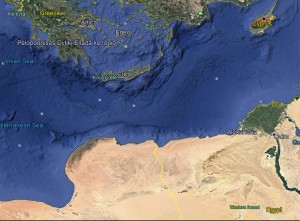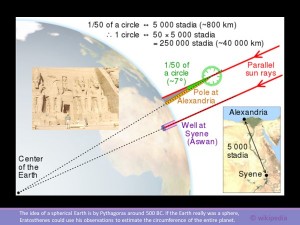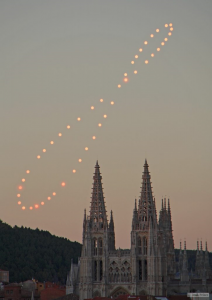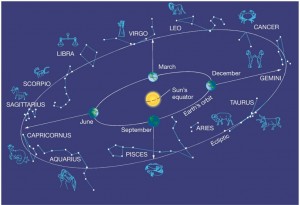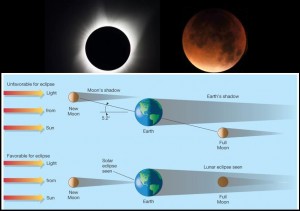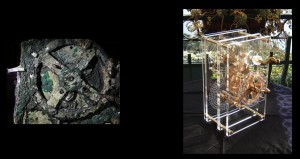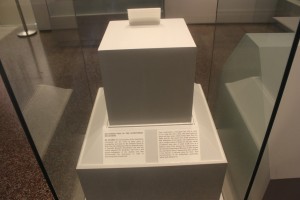This is the story of a journey through Greece, Egypt, Turkey and Russia following the footprint of the Greeks astronomers who invented the Astronomy. Their best instruments were the naked eyes and the brain. We can follow his teaching using our eyes. However, binoculars or a small telescope are not out of place.
[Click on the images to zoom]
Looking at the Sky with the naked eyes
Despite the reduced number of celestial bodies that can be seen with the naked eye, it’s surprising how much knowledge of the sky astronomers already had before the invention of the telescope.
Contemplating the sky on a starry night, away from light pollution, is one of the most fascinating shows that we can enjoy. It’s not strange then that for millennia humans have looked up at the sky and realized that the sun and the moon follow regular cycles. The majority of ancient cultures came up with mythological or religious explanations about celestial objects but they also used those objects for practical purposes such as the creation of calendars to schedule harvests.
The Earth is round
Almost everyone knows that the Earth is round except the members of the Flat Earth Society. To know it we only need look at this image (It was taken by the Lunar Reconnaissance Orbiter (a Nasa satellite). In this view, Africa and Iberian Peninsula are clearly visible). It was known by the Greeks 2500 years ago.
Crossing the Mediterranean sea from Greece to northern Africa
(From Google Map)
Travelers crossing the Mediterranean see from Athens to northern Africa observed different stars on the horizon. A plausible explanation is that the Earth was round.
I travelled around some Greek islands to know the places where Hipparchus of Nicaea (born in Turkey and died in Rhodes), Claudius Ptolemy (Alexandria), Archimedes of Syracuse and Pythagoras of Samos had lived to feel how they understood the world. I do not know another case in history where so many geniuses lived at the same time (VIII-II B.C.) in such a small area.
You can see in this image (taken by me): The enigmatic phaistoc disc in Crete, where the sailors started the travel to northern Africa (mainly Egypt). I said before that the sailors could see some stars close to the horizon when they were going to Africa that were not visible in Greece.
They also realized that in the boats the prow and the stern disappeared below the horizon before the head of the mast. A plausible explanation is that the Earth was round. But our next personage: Eratosthenes, a mathematician and head of the famous Alexandria Library, went beyond.
Eratosthenes and the measurement of the Earth
Eratosthenes had heard that in Syene (Aswan) no shadows reached a well at noon on June 21-st (the summer solstice) . The sun was directly overhead. He realized that it did not happen in Alexandria. Eratosthenes hired a man to measure walking the distance between both cities. He could then use a simple ratio (because Alexandria and Syene are almost in the same meridiam) to find the Earth’s circumference — 360/7 degrees is around 50. The distance measured was 5000 stadia, about 800 km, so 800 x 50 is about 40000 km.
The Moon
It was known that the Moon follows a cycle of 29.5 days from one new Moon to the next. The Greeks also knew that the phases of the moon can be explained assuming that the Sun is farther than the Moon and that the Earth is a sphere.
The Solar analemma
The Greeks realized that the sun describes in a year a curve (called analemma). This means that the sun follows a cycle along the year. We can get a lot of information from an analemma.
At present a Solar analemma can be obtained with a camera and patience (see the image: Analemma about Catedral de Burgos), taking pictures of the horizon every day or almost every day of the year from the same position and at the same solar time.
The stars
Stars are perhaps the most fundamental component of the universe. We can observe with naked eyes about 3 000 stars. But using an easy telescope we find many more. There are in the observable universe as many stars as grains of sand in all the beaches of the world. The Greeks and many cultures have imagined that the stars represent mythical stories.
Here, we see displayed one of the most easily recognizable star fields in the winter sky—the familiar constellation Orion. Below Orion is Sirius. Egyptian knew that the bright star Sirius preceded the annual flooding of the Nile. This happened every 365 days.
When I look at Orion, I remember the last words of the replicant Roy Batty in the film Blade Runner. “I’ve seen things you people wouldn’t believe. Attack ships on fire off the shoulder of Orion. … All those moments will be lost in time, like tears in rain. Time to die.”
Even the fixed stars change the relative position considering a long period. Hipparchus of Nice (c. 190 BC — c. 120 BC) realized that there was a relative movement of the stars with respect to the ecliptic over very long periods. This movement is nowadays known as the precession of the equinoxes. This is probably his most famous discovery. The displacement happens when the Earth’s axis, moving along a circumference with respect to the ecliptic, rotates with a period of 25,771 years. As a result, the North celestial pole keeps on moving. Today it is close to the North Star but 4,800 years ago it was pointing toward Thuban (Alpha Draconis). William Shakespeare did not realize that, when in his play Julius Caesar stated: “But I am constant as the northern star”.
The zodiacal constellations
(Source: Astronomy Today by Chaisson and McMillan. Pearson) The arrows indicate the most prominent zodiacal constellations in the night sky at various times of year. For example, in June, when the Sun is “in” Gemini, Sagittarius and Capricornus are visible at night. However the position of constellation has changed since Greek to know (e. g. Leo at present is: 10 August – 15 September, s. V. B.C: 21/7 – 21/8)The 12 constellations named here make up the astrological zodiac (There are 13 but Ophiuchus was forgotten). The view of the night sky changes as Earth moves in its orbit about the Sun. As drawn here, the night side of Earth faces a different set of constellations at different times of the year
The sky changes with the seasons, here are shown the constellation close to the horizon. It is incredible, but some people believe that the future is written in our zodiac sign. It is a hoax. The zodiac constellations have changed their position along the time.
My total solar eclipse (Novosibirsk 2008)
Some years ago I crossed Russia following the Trans-Siberian railway. My destination was Novosibirsk, the capital of Siberia.
I had planned the trip years in advance. I knew that a total solar eclipse would occur on August 1st 2008. I confess that the show exceeded my expectations. A brilliant diamond ring marks the beginning of the totality (phase where the Sun disappear).
A total solar eclipse is one of the most astonishing spectacles that all people should see at least once in one’s lifetime .
An eclipse occurs when the Earth, the Moon, and the Sun are aligned. The Moon’s orbit is inclined at about 5° to the ecliptic, so not all configurations are favorable to producing an eclipse. For an eclipse to occur, the line of intersection of the two planes must lie along the Earth–Sun line. Thus, eclipses can occur just at specific times of the year.
The astronomical models
The image represents in the left the Aristotle’s model and in the right the enhanced introduced by Ptolemy to explain the path of the planets (wandering stars)
Greeks thought that all stars were at the same distance, but it is not what it is seems. The Greeks distinguish two types of stars: The “fixed stars” and the “wandering stars” our Planets. Fixed stars don`t change (apparently) their position with respect to the other stars. The red color in the image is the path of Mars.
The Almagest by Claudius Ptolemy gives an explanation of the apparent motions of the stars and planetary paths. It was used during 1500 years until that Copernicus and Galileo proposed the heliocentric model.
Since the beginning of time humans have looked at to the sky searching for an explanation. The Greeks were the first ones to find a rational description of the movement of sky bodies.
The Antikythera mechanism
( The original Antikythera mechanism and a reconstruction)
The Antikythera mechanism is considered the first computer: it was used to predict astronomical events such as positions of some celeste bodies and eclipses for calendar.
I had studied the Antikythera mechanism. It was made by a disciple of Archimedes of Syracuse. When I went to Athens, I expected to see it in the National Archaeological Museum of Athens, but…
In the image the showcase where the Antikythera mechanism should be. I felt disappointed when I scrutinize the showcase where the Antikythera mechanism should be but it was empty only a text: Antikythera mechanism has been removed to research.
A pale blue dot
When the Voyager 1 (a space probe) reached a position beyond Saturn orbit took a photo where it can be see a small blue dot: The Earth. We should remember that all the humans are a single species that lives in this pale blue dot: The Earth: “Look again at that dot. That’s here. That’s home. That’s us. On it everyone you love, everyone you know, everyone you ever heard of, every human being who ever was, lived out their lives” Carl Sagan https://www.youtube.com/watch?v=GO5FwsblpT8.
Thanks to Maria Balasopaulou my Greek Teacher of English and my colleagues of the Senior English Course 2017-18
José Guillermo Sánchez León



